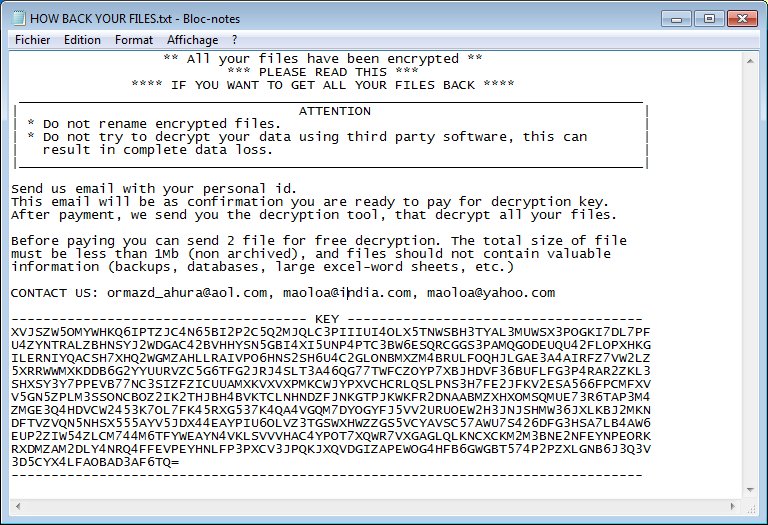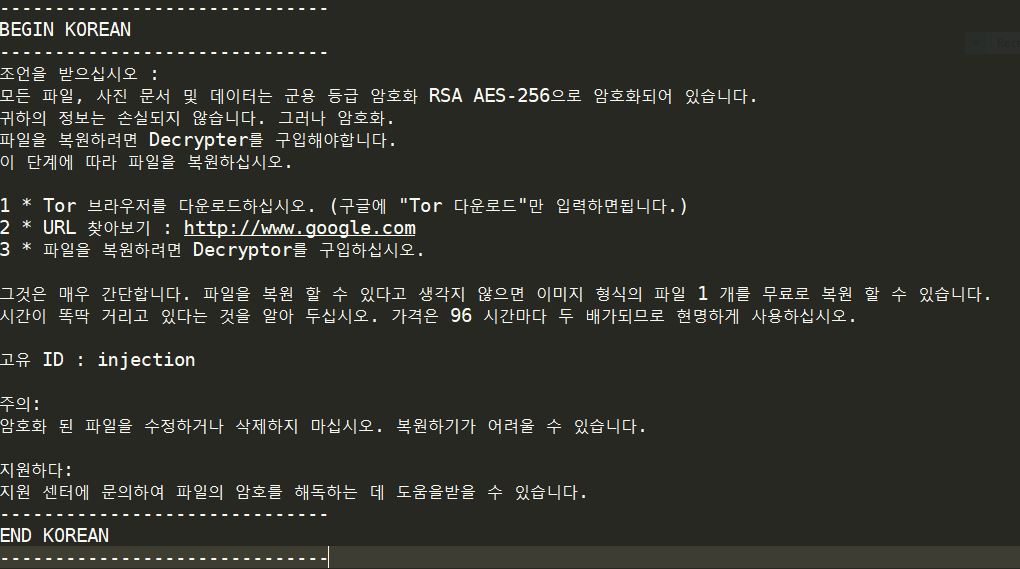What is Maoloa ransomware? And how does it carry out its attack?
Maoloa ransomware is a file-encrypting malware discovered on the first week of February 2019. Like other typical ransomware threats, this one is also designed to lock important data in a computer and demand ransom from victims. It uses the “.maoloa” extension in marking its encrypted files and urges users to contact email addresses such as [email protected], [email protected], [email protected].
Once it infiltrates a computer, Maoloa ransomware will drop its malicious payload which initiates the attack by connecting the computer to a remote server. After that, it downloads its malicious components and drops them on several system folders which are used to manipulate system processes and employ several modules like the information gathering module and stealth protection module.
It first employs the information gathering module which gathers information from the computer. The information gathered may consist of machine identification data and personal information of the user. The collected information is then used to bypass any security software in the system by looking for engines of applications that can block the attack of Maoloa ransomware. Furthermore, it also alters the Windows Registry by modifying existing entries and creating new ones to allow it to run automatically each time the infected computer is turned on. After these system changes, it starts the encryption using a sophisticated encryption algorithm and once the encryption is finished, it appends the .maoloa suffix to all the affected files. It then drops a text file named HOW BACK YOUR FILES.txt which contains the following content:
“** All your files have been encrypted **
*** PLEASE READ THIS ***
**** IF YOU WANT TO GET ALL YOUR FILES BACK ****
_______________________________________________________
| ATTENTION |
| * Do not rename encrypted files. |
| * Do not try to decrypt your data using third party software, this can |
| result in complete data loss. |
|_______________________________________________________|
Send us email with your personal id.
This email will be as confirmation you are ready to pay for decryption key.
After payment, we send you the decryption tool, that decrypt all your files.
Before paying you can send 2 file for free decryption. The total size of file
must be less than 1Mb (non archived), and files should not contain valuable
information (backups, databases, large excel-word sheets, etc.)
CONTACT US: [email protected], [email protected], [email protected]
————————————- KEY ————————————-”
How is the malicious payload of Maoloa ransomware disseminated over the web?
The malicious payload of Maoloa ransomware may be disseminated using several techniques. For one, it could spread via malicious spam email campaigns where crooks attach an infected link or file. Usually, the email is disguised as something urgent to trick users into opening them and clicking the link or downloading the infected file attached to it. This is why you need to be more cautious in opening emails no matter who the sender is.
Delete Maoloa ransomware from your infected computer with the help of the following removal guide.
Step 1: First, tap the Ctrl + Shift + Esc keys in your keyboard to open the Task Manager.
Step 2: After opening the Task Manager, go to the Processes tab and look for any suspicious-looking process that takes up most of your CPU’s resources and is most likely related to Maoloa ransomware.

Step 3: After that, close the Task Manager.
Step 4: Tap Win + R, type in appwiz.cpl and click OK or tap Enter to open Programs and Features under Control Panel.
Step 5: Under the list of installed programs, look for Maoloa ransomware or anything similar and then uninstall it.

Step 6: Next, close Control Panel and tap Win + E keys to launch File Explorer.
Step 7: Navigate to the following locations below and look for Maoloa ransomware’s malicious components such as HOW BACK YOUR FILES.txt and [random].exe and other suspicious files, then delete all of them.
- %TEMP%
- %WINDIR%\System32\Tasks
- %APPDATA%\Microsoft\Windows\Templates\
- %USERPROFILE%\Downloads
- %USERPROFILE%\Desktop
Step 8: Close the File Explorer.
Before you proceed to the next steps below, make sure that you are tech savvy enough to the point where you know exactly how to use and navigate your computer’s Registry. Keep in mind that any changes you make will highly impact your computer. To save you the trouble and time, you can just use [product-name], this system tool is proven to be safe and excellent enough that hackers won’t be able to hack into it. But if you can manage Windows Registry well, then by all means go on to the next steps.
Step 9: Tap Win + R to open Run and then type in regedit in the field and tap enter to pull up Windows Registry.

Step 10: Navigate to the following path:
- HKEY_CURRENT_USER\Control Panel\Desktop\
- HKEY_USERS\.DEFAULT\Control Panel\Desktop\
- HKEY_LOCAL_MACHINE\Software\Microsoft\Windows\CurrentVersion\Run
- HKEY_CURRENT_USER\Software\Microsoft\Windows\CurrentVersion\Run
- HKEY_LOCAL_MACHINE\Software\Microsoft\Windows\CurrentVersion\RunOnce
- HKEY_CURRENT_USER\Software\Microsoft\Windows\CurrentVersion\RunOnce
Step 11: Delete the registry keys and sub-keys created by Maoloa ransomware.
Step 12: Close the Registry Editor and empty the Recycle Bin.
Try to recover your encrypted files using the Shadow Volume copies
Restoring your encrypted files using Windows’ Previous Versions feature will only be effective if Maoloa ransomware hasn’t deleted the shadow copies of your files. But still, this is one of the best and free methods there is, so it’s definitely worth a shot.
To restore the encrypted file, right-click on it and select Properties, a new window will pop-up, then proceed to Previous Versions. It will load the file’s previous version before it was modified. After it loads, select any of the previous versions displayed on the list like the one in the illustration below. And then click the Restore button.

Complete the removal process of Maoloa ransomware by using a trusted and reliable program like [product-name]. Refer to the following guidelines on how to use it.
Perform a full system scan using [product-code]. To do so, follow these steps:
- Turn on your computer. If it’s already on, you have to reboot it.
- After that, the BIOS screen will be displayed, but if Windows pops up instead, reboot your computer and try again. Once you’re on the BIOS screen, repeat pressing F8, by doing so the Advanced Option shows up.

- To navigate the Advanced Option use the arrow keys and select Safe Mode with Networking then hit
- Windows will now load the Safe Mode with Networking.
- Press and hold both R key and Windows key.

- If done correctly, the Windows Run Box will show up.
- Type in the URL address, [product-url] in the Run dialog box and then tap Enter or click OK.
- After that, it will download the program. Wait for the download to finish and then open the launcher to install the program.
- Once the installation process is completed, run [product-code] to perform a full system scan.

- After the scan is completed click the “Fix, Clean & Optimize Now” button.












